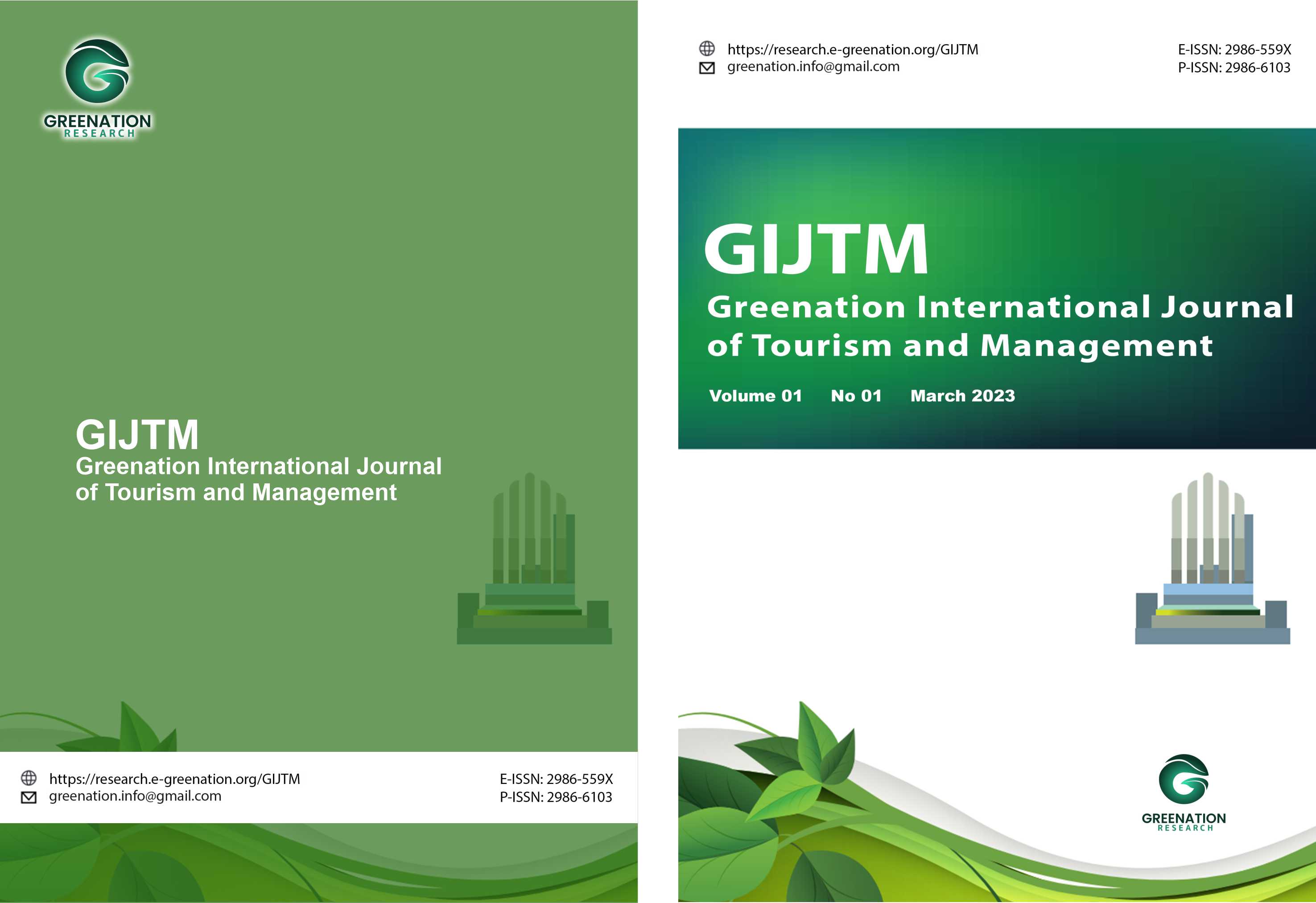Understanding Youth Attraction to Designer Clothing
DOI:
https://doi.org/10.38035/gijtm.v2i4.310Keywords:
Designer Clothing, Youth Perceptions, Fashion Consumption, Social Dynamics, Social PressuresAbstract
This research paper investigates the impact of designer clothing on youngsters, focusing on their perceptions, motivations, and the associated social dynamics. Through an analysis of variance (ANOVA), the study explores key questions surrounding the appeal of designer brands, common criticisms, and potential negative consequences of such consumption. The results indicate that while many youths are attracted to designer apparel for its status and quality, they also express concerns regarding its exclusivity and the pressure to conform to social expectations. Notably, the analysis reveals significant differences in perceptions about the negative consequences of wearing designer clothes, highlighting a recognition among youngsters of the potential for social isolation or financial strain associated with high-fashion choices. Additionally, the study examines how designer brands market their products to appeal to a younger audience, identifying strategies that leverage social media and influencer marketing. Overall, the findings illustrate a complex interplay between fashion choices, identity formation, and peer relationships in the lives of young consumers. This paper contributes to a broader understanding of how designer clothing influences youth culture and consumer behavior in contemporary society, providing valuable insights for marketers, educators, and parents.
References
Aakko, M., & Niinimäki, K. (2022). Quality matters: reviewing the connections between perceived quality and clothing use time. Journal of Fashion Marketing and Management: An International Journal, 26(1), 107–125. https://doi.org/10.1108/JFMM-09-2020-0192
Arrigo, E. (2022). Digital platforms in fashion rental: a business model analysis. Journal of Fashion Marketing and Management: An International Journal, 26(1), 1–20. https://doi.org/10.1108/JFMM-03-2020-0044
Atarah, B. A., Finotto, V., Nolan, E., & van Stel, A. (2023). Entrepreneurship as emancipation: a process framework for female entrepreneurs in resource-constrained environments. Journal of Small Business and Enterprise Development, 30(4), 734–758. https://doi.org/10.1108/JSBED-05-2022-0243
ben Hassen, T., & Tremblay, D.-G. (2019). Local rooting and creativity within the fashion industry in Beirut. EuroMed Journal of Business, 14(2), 92–109. https://doi.org/10.1108/EMJB-12-2018-0090
Bonfanti, A., Vigolo, V., Vannucci, V., & Brunetti, F. (2023). Creating memorable shopping experiences to meet phygital customers’ needs: evidence from sporting goods stores. International Journal of Retail & Distribution Management, 51(13), 81–100. https://doi.org/10.1108/IJRDM-12-2021-0588
Cantrell, Y., & Zhu, X. A. (2022). Choice-based games and resilience building of gender nonconforming individuals: a phenomenological study. Digital Transformation and Society, 1(2), 198–218. https://doi.org/10.1108/DTS-08-2022-0039
Cluley, R., & Green, W. (2019). Social representations of marketing work: advertising workers and social media. European Journal of Marketing, 53(5), 830–847. https://doi.org/10.1108/EJM-12-2016-0682
Cortiñas, M., Chocarro, R., & Elorz, M. (2019). Omni-channel users and omni-channel customers: a segmentation analysis using distribution services. Spanish Journal of Marketing - ESIC, 23(3), 415–436. https://doi.org/10.1108/SJME-06-2019-0031
Dalziel, R. C., & de Klerk, N. (2021). Media and group influence on Generation Y consumers’ attitudes towards beauty products. Spanish Journal of Marketing - ESIC, 25(1), 115–136. https://doi.org/10.1108/SJME-12-2019-0104
Dey, B. L., Balmer, J. M. T., Pandit, A., & Saren, M. (2018). Selfie appropriation by young British South Asian adults. Information Technology & People, 31(2), 482–506. https://doi.org/10.1108/ITP-08-2016-0178
Diaz Ruiz, C., & Cruz, A. G. B. (2023). Unconventional luxury brand collaborations: a new form of luxury consumption among young adults in China. International Marketing Review, 40(7), 1–21. https://doi.org/10.1108/IMR-04-2022-0099
Dissanayake, K., & Pal, R. (2023). Sustainability dichotomies of used clothes supply chains: a critical review of key concerns and strategic resources. The International Journal of Logistics Management, 34(7), 75–97. https://doi.org/10.1108/IJLM-10-2022-0410
Fróes, I. (2019). The Digital Play Experience Taxonomy (DPET): Mapping and Categorising the Digital Play Experience. In Young Children’s Play Practices with Digital Tablets (pp. 77–103). Emerald Publishing Limited. https://doi.org/10.1108/978-1-78756-705-420191008
Fu, X., Sittithai, T., & Chankoson, T. (2023). Factors affecting the development of Lipu Yi costumes: intangible cultural heritage tourism. Journal of Cultural Heritage Management and Sustainable Development, ahead-of-print(ahead-of-print). https://doi.org/10.1108/JCHMSD-05-2022-0068
Gao, Y., & Huber, E. (2024). Citizen scholars: cultivating 21st century graduate competencies in business education. Journal of Work-Applied Management, 16(2), 200–217. https://doi.org/10.1108/JWAM-10-2023-0119
Gopura, S., & Wickramasinghe, A. (2024). Weaving emotions: unraveling the emotional significance of Sri Lankan handloom artistry. Journal of Humanities and Applied Social Sciences, 6(4), 315–330. https://doi.org/10.1108/JHASS-07-2023-0082
Hosain, M. S., & Mamun, A. M. A. (2023a). Facebook-based social media marketing and Facebook-based online purchases: evidence from the Facebook page admins of selected South Asian fashion retailers. Journal of Electronic Business & Digital Economics, 2(2), 191–212. https://doi.org/10.1108/JEBDE-03-2023-0005
Hosain, M. S., & Mamun, A. M. A. (2023b). The nexus between social media advertising and customers’ purchase intention with the mediating role of customers’ brand consciousness: evidence from three South Asian countries. Business Analyst Journal, 44(2), 84–105. https://doi.org/10.1108/BAJ-06-2023-0053
Jacobson, J. (2020). You are a brand: social media managers’ personal branding and “the future audience.” Journal of Product & Brand Management, 29(6), 715–727. https://doi.org/10.1108/JPBM-03-2019-2299
Jahre, M., Kembro, J., Adjahossou, A., & Altay, N. (2018). Approaches to the design of refugee camps. Journal of Humanitarian Logistics and Supply Chain Management, 8(3), 323–345. https://doi.org/10.1108/JHLSCM-07-2017-0034
Japutra, A., Loureiro, S. M. C., Wang, S., & Primanti, H. (2023). How can brands become central in the consumers’ life? Spanish Journal of Marketing - ESIC, 27(1), 39–59. https://doi.org/10.1108/SJME-05-2022-0094
Jayatilleke, B. G., & Gunawardena, C. (2016). Cultural perceptions of online learning: transnational faculty perspectives. Asian Association of Open Universities Journal, 11(1), 50–63. https://doi.org/10.1108/AAOUJ-07-2016-0019
Kallioharju, M., Wilska, T.-A., & Vänskä, A. (2023). Mothers’ self-representations and representations of childhood on social media. Young Consumers, 24(4), 485–499. https://doi.org/10.1108/YC-06-2022-1541
Karunasingha, A., & Abeysekera, N. (2022). The mediating effect of trust on consumer behavior in social media marketing environments. South Asian Journal of Marketing, 3(2), 135–149. https://doi.org/10.1108/SAJM-10-2021-0126
Laato, S., Inaba, N., Paloheimo, M., & Laajala, T. D. (2021). Group polarisation among location-based game players: an analysis of use and attitudes towards game slang. Internet Research, 31(5), 1695–1717. https://doi.org/10.1108/INTR-03-2020-0158
Lavoye, V., Sipilä, J., Mero, J., & Tarkiainen, A. (2023). The emperor’s new clothes: self-explorative engagement in virtual try-on service experiences positively impacts brand outcomes. Journal of Services Marketing, 37(10), 1–21. https://doi.org/10.1108/JSM-04-2022-0137
Loney-Howes, R. (2020). The Politics of Recognition and Representation. In Online Anti-Rape Activism: Exploring the Politics of the Personal in the Age of Digital Media (pp. 87–119). Emerald Publishing Limited. https://doi.org/10.1108/978-1-83867-439-720201007
Madinga, N. W., Blanckensee, J., Longhurst, L., & Bundwini, N. (2023). The new normal: the adoption of food delivery apps. European Journal of Management Studies, 28(3), 175–192. https://doi.org/10.1108/EJMS-03-2023-0021
Muposhi, A., & Chuchu, T. (2024). Influencing millennials to embrace sustainable fashion in an emerging market: a modified brand avoidance model perspective. Journal of Fashion Marketing and Management: An International Journal, 28(4), 738–758. https://doi.org/10.1108/JFMM-07-2021-0169
Ndofirepi, T. M., Chuchu, T., Maziriri, E., & Nyagadza, B. (2022). Examining the influence of price-quality inference and consumer attitudes on the inclination to buy non-deceptive counterfeit goods: evidence from South Africa. European Journal of Management Studies, 27(3), 317–339. https://doi.org/10.1108/EJMS-04-2022-0026
Ng, P. Y., Wood, B. P., & Bastian, B. L. (2022). Reformulating the empowerment process through women entrepreneurship in a collective context. International Journal of Entrepreneurial Behavior & Research, 28(9), 154–176. https://doi.org/10.1108/IJEBR-06-2021-0479
Oniku, A., & Joaquim, A. F. (2022). Female sexuality in marketing communication and effects on the millennial buying decisions in fashion industry in Nigeria. Rajagiri Management Journal, 16(2), 105–117. https://doi.org/10.1108/RAMJ-09-2020-0055
Phau, I., Akintimehin, O. O., Shimul, A. S., & Lee, S. (2024). Unlocking the motivations behind vintage luxury desire. Spanish Journal of Marketing - ESIC, ahead-of-print(ahead-of-print). https://doi.org/10.1108/SJME-06-2023-0167
Rahman, M. F., & Hossain, M. S. (2023). The impact of website quality on online compulsive buying behavior: evidence from online shopping organizations. South Asian Journal of Marketing, 4(1), 1–16. https://doi.org/10.1108/SAJM-03-2021-0038
Rasheed, E. O., & Rotimi, J. O. B. (2024). The green office environment: New Zealand workers’ perception of IEQ. Smart and Sustainable Built Environment, 13(5), 1240–1259. https://doi.org/10.1108/SASBE-09-2022-0204
Sacco, F., & Conz, E. (2023). Corporate heritage communication strategies of iconic Italian brands: a multiple case study. Corporate Communications: An International Journal, 28(7), 19–43. https://doi.org/10.1108/CCIJ-12-2021-0136
Salminen, J., Santos, J. M., Jung, S., & Jansen, B. J. (2023). How does an imaginary persona’s attractiveness affect designers’ perceptions and IT solutions? An experimental study on users’ remote working needs. Information Technology & People, 36(8), 196–225. https://doi.org/10.1108/ITP-09-2022-0729
Söderlund, M., & Oikarinen, E.-L. (2021). Service encounters with virtual agents: an examination of perceived humanness as a source of customer satisfaction. European Journal of Marketing, 55(13), 94–121. https://doi.org/10.1108/EJM-09-2019-0748
Soliman, N. (2023). Exploring slum life and urban poverty in Lagos: the politics of everyday resistance in Chris Abani’s Graceland. Journal of Humanities and Applied Social Sciences, 5(5), 467–482. https://doi.org/10.1108/JHASS-01-2023-0017
Spitzer, P. A. (2023). Oral Histories from Around the World. In Empowering Female Climate Change Activists in the Global South: The Path Toward Environmental Social Justice (pp. 59–104). Emerald Publishing Limited. https://doi.org/10.1108/978-1-80382-919-720231005
Taeger, S. (2020). Using narrative distance to invite transformative learning experiences. Journal of Research in Innovative Teaching & Learning, 13(2), 211–227. https://doi.org/10.1108/JRIT-05-2019-0057
Thomasen, K., & Dunn, S. (2021). Reasonable Expectations of Privacy in an Era of Drones and Deepfakes: Expanding the Supreme Court of Canada’s Decision in R v Jarvis. In J. Bailey, A. Flynn, & N. Henry (Eds.), The Emerald International Handbook of Technology-Facilitated Violence and Abuse (pp. 555–576). Emerald Publishing Limited. https://doi.org/10.1108/978-1-83982-848-520211040
Tosca, S. (2023a). Good Artists Copy, Great Artists Steal: 1 Creativity and Originality in a New Media Landscape. In Sameness and Repetition in Contemporary Media Culture (pp. 141–167). Emerald Publishing Limited. https://doi.org/10.1108/978-1-80455-952-920231007
Tosca, S. (2023b). If You Liked That, You Will Love This: On Sameness-Based Algorithmic Recommendation Systems. In Sameness and Repetition in Contemporary Media Culture (pp. 113–140). Emerald Publishing Limited. https://doi.org/10.1108/978-1-80455-952-920231006
Downloads
Published
How to Cite
Issue
Section
License
Copyright (c) 2025 Dev Nagdevani, Bhavya Petel, Pooja Jaju, Aditya Sah, Ruchi Sapra, Gul Kacchara, Rahul Chauhan, Andino Maseleno

This work is licensed under a Creative Commons Attribution 4.0 International License.
Copyright :
Authors who publish their manuscripts in this journal agree to the following conditions:
- Copyright in each article belongs to the author.
- The author acknowledges that the Greenation International Journal of Tourism and Management (GIJTM) has the right to be the first to publish under a Creative Commons Attribution 4.0 International license (Attribution 4.0 International CC BY 4.0).
- Authors can submit articles separately, arrange the non-exclusive distribution of manuscripts that have been published in this journal to other versions (for example, sent to the author's institutional repository, publication in a book, etc.), by acknowledging that the manuscript has been published for the first time at GIJTM.


























